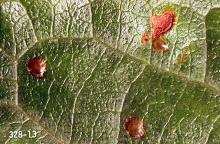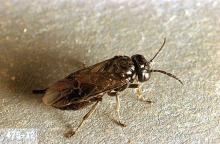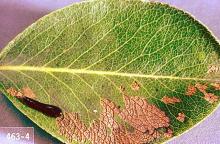California pear sawfly (Pristiphora abbreviata)
Pear slug (Caliroa cerasi)
Pest description and damage Pear slug is a European insect now found in most areas of the U.S. It attacks both pear and cherry and is found on mountain ash, hawthorn, and ornamental Prunus. The adult is a glossy black fly-like insect, about 0.2 inch in length. The larva initially resembles a small tadpole due to the olive-green slime that covers the body, and the head being wider than the rest of the body. Mature larvae are 0.375 inch in length and orange yellow. Larvae feed on the upper surface of leaves, skeletonizing them. Heavy feeding causes leaf drop, reduction in vigor and yield, particularly on young trees. California pear sawfly is found occasionally defoliating pear trees. Larvae eat round holes in leaf, with extensive feeding only the midrib will remain. The larvae are bright green, closely matching the leaf color, and feed along the edges of leaves. A minor pest in orchards, it can severely defoliate ornamental pears.
Biology and life history Pear slug overwinters as a pupa in a cocoon two to three inches deep in the soil. Adults emerge over an extended period in late April-May. The adult female inserts eggs into leaf tissue, and eggs hatch in 10 to 15 days. Larvae immediately begin to feed on the upper surface of the leaf. After three to four weeks, they drop to the soil to pupate. Second generation adults emerge in July and larvae from this generation feed in August and September. Most larvae from this generation drop to the ground to overwinter.
Pest monitoring Watch trees for the slug-like larvae or skeletonized leaves in early spring to indicate potential for defoliation by subsequent generations, and again in August and September when large populations can build up. Watch for the caterpillar-like bright green sawflies on pear or telltale leaf skeletons consisting of only midrib and main veins caused by California pear sawfly.
Management-biological control
Specific biocontrol agents are not known, but this is rarely a pest in backyard gardens, so significant biocontrol likely occurs most years.
Management-cultural control
Pick off or squash individual larvae or wash them off with a strong stream of water. Old records recommended fine road dust (or other fine powder to stick to the slimy surface and suffocate the pear slug larvae.
Management-chemical control
See Table 2 in:
Chemical Control of Landscape Pests
For more information
See "Sawfly" in:
Anon. 2008. California pear sawfly (http://www.ucipm.ucdavis.edu/PMG/r603301811.html)




